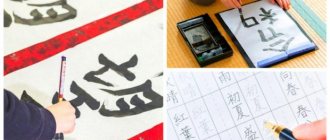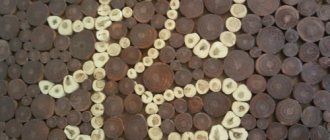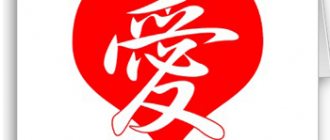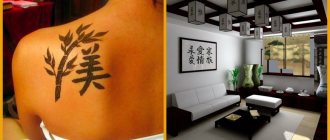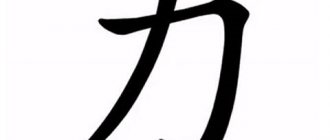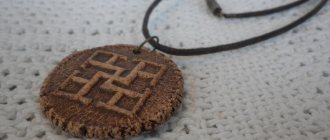Chinese and Japanese characters always carry a semantic load, reflecting individual meaning and purpose. Residents of these Asian countries endow each such symbol with special energy in order to get the desired result and fulfill their own dreams.
An important character in Japanese and Chinese writing is “strength,” which is of great importance to the people of China and Japan. These symbols are considered favorable and happy in both countries, but this sign must be used carefully so as not to upset the energy balance.
Features of Chinese characters
Each character in the Chinese language has its own specific meaning and semantic load, which are closely related to other features of this writing system. These complex symbols have enormous energy, which in reality can help achieve the desired results and implement all plans. The Chinese character for "strength" is an auspicious and positive pictogram. These symbols must be used with caution, since each sign in Chinese writing has an ambiguous and specific meaning, which is often understandable only to native speakers, professional linguists and philologists.
On the foot
Men love to get Chinese hieroglyph tattoos on their thighs and calves. For these places it is better to use thicker lines and interesting fonts. Again, no one forbids adding a beautiful drawing.
But on the feet, Japanese characters are found mainly in women. Neat thin lines that make up the hieroglyph decorate a woman’s leg and add elegance. With the help of a small tattoo, your ankle or ankle will look especially feminine.
Character strength in Chinese
The character 力 (li— read as “li”) is translated as “strength, power.” It can also have the following meanings: energy, aspiration, opportunity, impact. This symbol (力 (lì) is an image of a person bending down to lift something using physical force. The vertical line 丿 symbolizes the hand, and the hook-like curve represents the hand. The Chinese character for "strength" can also be considered depicting a plow, that is, a heavy object that requires muscular strength.
Examples of expressions that use the pictogram 力 (li):
- 力量 (li liang - li liang) - strength, power, energy, and volume, (量, liang) - strength (plural);
- 力 (lì); 用力 (yongli - yun li) - try very hard, literally “use force” 用 (yòng - yun);
- 有力 (yo u li - yu li) - physically strong, large, literal translation - “possessing strength or power” (有, y ou);
- Horsepower is translated as 馬力 (ma li - ma li), 馬 (ma) - translated as horse, horse.
- The force of the wind is called 風力 (feng li feng li), 風 (feng) means gust of wind.
Ideas for tattoos: hieroglyphs and their translation
Most symbols for tattoos are auspicious hieroglyphs from Feng Shui, which are used to wish good things or attract good luck.
Video about the meaning behind popular Chinese characters used in tattoos:
Happiness
幸福consists of two parts, each of which can be depicted separately, as it has its own meaning and sound. The first character, 幸 (shin) means happy, prosperous, and the second - 福 (fu) means “blessing”, “joy”, “prosperity”, “peace”. That is, the hieroglyph reflects the Chinese idea of happiness as God’s blessing for well-being in all areas of life.
The image is intended to bring happiness and good luck to the wearer precisely in the area in which he asks from higher powers.
Great happiness
喜喜is a double-written character for “joyful” (si), which also means “cheerfulness.” It is considered a powerful talisman that brings growth in various areas, from the birth of children to good luck in business. It is recommended for application as a talisman for success in family relationships or matters related to partnership, since the sign is paired.
Love
愛 (ai) consists of four components: claw, roof, heart, paws. That is, in it you can find a symbolic description of love: “a feeling that pierces the heart, settles in it and does not allow it to escape.” The image is used as a talisman to attract love, find a soul mate, harmony and joy in family life, and strengthen marriage.
Eternal love
永愛 (yong ai) consists of two parts. The first element means “long”, “endless”. This element contains the key water with the meaning current long. The hieroglyph is used as a talisman to strengthen love and friendship, gives mutual understanding to partners, and brings a new wave of feelings into the relationship between spouses.
Wealth
富 (fu) contains parts such as abundance and building, that is, it depicts prosperity in the house. This hieroglyph attracts not only material values, but also spiritual wealth associated with gaining knowledge about life. It is considered a good talisman for success in business and business well-being.
Material wealth is also symbolized by the character 錢 (money), which is also used to attract wealth.
Prosperity
繁荣 (fanrong) is a character consisting of two parts, the first character means “numerous”, “in large numbers”, the second character means “glory”, “honours”, “popularity”. It is used as a talisman to attract not only material well-being, improvement in business, but also the accompanying honor and respect, good fame about a person and his business.
The stylized spelling of the first character 繁 is often used to protect against failure in any area.
Abundance
The hieroglyph resembles a bowl of ears of corn (a symbol of a rich harvest). This image is used to attract the energy of growth in any area. You can add a second symbol with the image of the “object of desire”, which will enhance the effect of the sign. The hieroglyph is also a talisman against poverty and decline.
Force
力 (li) – looks like a strong hand pointing downwards. It is believed that the symbol fills its wearer with internal energy and vigor, and gives confidence in oneself and one’s actions. A talisman tattoo will also give you strength to implement creative plans and give you new ideas.
Joy
樂 (yue, le) - interpreted not only as “joy”, but also as “pleasure”, “fun” and “music”. The talisman is designed to fill the wearer with positive emotions, help to live easily, and cure sorrows.
Health
The character 健康 (jiang kang) brings the greatest value to the owner - good health. Helps solve problems with poor health, overcome mental crises. Health in the broadest sense of the word.
You can find the first symbol separately as a wish for recovery during treatment.
World
The Chinese symbol 和 (Heipin) , which means “peaceful,” “good-natured,” calm,” is applied to give a person peace of mind and also as a talisman for good, smooth relationships with others.
beauty
The symbol 美 (mei) is very popular as a tattoo for women , which is often applied along with the image of flowers that represent purity. The talisman is designed to provide the owner with beauty and health. Previously, the hieroglyph had the meaning “peaceful”, as it combined the image of a man and a lamb (literally “meek as a lamb”).
Independence
獨立 (du li) literally means “standing apart”, free from force, influence, authority. There are stylized writing options. Used as a talisman for liberation from addiction, bad habit.
Courage
The symbol 勇 (yong) is “courage” and combines the elements “brave” on top and “strength” on the bottom. The tattoo gives courage, perseverance and bravery to its owner. Often marked with the symbol 气 (xi), representing energy.
Dream
The hieroglyph 夢 (men) - “dream” is one of the most popular symbols for drawing, as it symbolizes movement towards a dream. But there is another meaning of the sign: “dream”, “illusion” and a hidden message - to take the transience and impermanence of life for granted.
Fulfillment of desires
如意 (ryuyi) literally means “quality of desire.” The message contained in this symbol on the tattoo reads: “May your dreams come true!” In Feng Shui, it is believed that by giving images of this hieroglyph to his friends, a person wishes them the fulfillment of all their aspirations and in return receives the fulfillment of their hopes.
Hieroglyph as a talisman
If you choose the hieroglyph “strength” as your own amulet, then it bestows vital energy, strength and activity. Not only your health, but also your psychological state may improve, and a feeling of self-confidence will appear. You will walk with your head held high, confident in your abilities. A person will become more ambitious, with more desires and creative ideas, plans, he can manifest himself as a bearer of creative potential. All these features will help change your life for the better.
The Chinese character “strength” has a very great influence on people involved in sports, businessmen, and creative people. This hieroglyph can help before the most important competition, deal, negotiations, creative competitions, and also energize you with victory.
It is necessary to place the power pictogram so that it is constantly with the person and in his sight. In principle, it can be located anywhere, its impact will not decrease, but there are zones where its influence is fully activated: in the zone of career growth, material wealth and prosperity, that is, in the north, southeast and south.
Table of Chinese Character Keys
Mastering and memorizing radicals in the Chinese language is one of the most difficult, but mandatory tasks for anyone who begins to learn this language. This is the very first step in learning hieroglyphs, without which it is impossible to move on. Subsequently, knowledge of the keys of the Chinese language with an explanation of the meaning of each of them will greatly facilitate the study of complex characters with a large number of features. Knowing the keys, you can guess the meaning of the hieroglyph , even if you see it for the first time. In addition, this will greatly simplify working with paper dictionaries, which may not be very relevant today, but may well be useful.
For more convenient study and work with them, all the main keys of Chinese characters are summarized in a table , where they are located depending on the number of traits they consist of (from 1 to 17). In addition to the radicals themselves and their spelling variants (including traditional), such tables contain Pinyin transcription and decoding of the keys of Chinese characters into Russian .
| № | Key | Spelling variations | Traditional option | Pinyin | Name in Russian | Number of devils | Trivial name |
| 1 | 一 | yi1 | unit | 1 | 横 | ||
| 2 | 丨 | gun3 | vertical | 1 | 竖 | ||
| 3 | 丶 | zhu3 | dot | 1 | 点 | ||
| 4 | 丿 | 乀, 乁 | pie3 | folding | 1 | 撇 | |
| 5 | 乙 | 乚, 乛 | yi3 | and, second | 1 | ||
| 6 | 亅 | jue2 | hook | 1 | |||
| 7 | 二 | er4 | two | 2 | |||
| 8 | 亠 | tou2 | lid | 2 | 点横部 | ||
| 9 | 人 | 亻 | ren2 | Human | 2 | 亻,单人旁人,人字头 | |
| 10 | 儿 | er2 | legs | 2 | |||
| 11 | 入 | ru4 | enter | 2 | |||
| 12 | 八 | 丷 | ba1 | eight | 2 | 八字旁 | |
| 13 | 冂 | jiong3 | lands far outside the city | 2 | 同字框 | ||
| 14 | 冖 | mi4 | cover | 2 | 秃宝盖 | ||
| 15 | 冫 | bing1 | ice | 2 | 两点水 | ||
| 16 | 几 | ji1 | table | 2 | |||
| 17 | 凵 | qu3 | open mouth | 2 | |||
| 18 | 刀 | 刂 | dao1 | knife | 2 | 刂, 立刀旁 | |
| 19 | 力 | li4 | force | 2 | 力字旁 | ||
| 20 | 勹 | bao1 | wrap | 2 | 包字头 | ||
| 21 | 匕 | bi3 | scoop | 2 | |||
| 22 | 匚 | fang1 | box | 2 | 三框 | ||
| 23 | 匸 | xi3 | hide | 2 | |||
| 24 | 十 | shi2 | ten | 2 | 十字 | ||
| 25 | 卜 | bu3 | divination | 2 | |||
| 26 | 卩 | jie2 | seal | 2 | 单耳刀 | ||
| 27 | 厂 | han4 | break | 2 | 厂字旁 | ||
| 28 | 厶 | si1 | private | 2 | 私字 | ||
| 29 | 又 | you4 | again | 2 | 又字旁 | ||
| 30 | 口 | kou3 | mouth | 3 | 口字旁 | ||
| 31 | 囗 | wei2 | territory with borders | 3 | 方框 | ||
| 32 | 土 | tu3 | Earth | 3 | 提土旁 | ||
| 33 | 士 | shi4 | pundit | 3 | |||
| 34 | 夂 | zhi3 (top) | walk | 3 | |||
| 35 | 夊 | sui1 (bottom) | walk slowly | 3 | |||
| 36 | 夕 | xi1 | evening | 3 | 夕字旁 | ||
| 37 | 大 | da4 | big | 3 | 大字头 | ||
| 38 | 女 | nü3 | woman | 3 | 女字旁 | ||
| 39 | 子 | 孑 | zi3 | child | 3 | 子字旁 | |
| 40 | 宀 | mian2 | roof | 3 | 宝盖 | ||
| 41 | 寸 | cun4 | tsun, vershok | 3 | 寸字旁 | ||
| 42 | 小 | xiao3 | small | 3 | 小字头 | ||
| 43 | 尢 | 尣 | wang1 | frail | 3 | ||
| 44 | 尸 | shi1 | dead body | 3 | 尸字头 | ||
| 45 | 屮 | che4 | sprout | 3 | |||
| 46 | 山 | shan1 | mountain | 3 | 山字旁 | ||
| 47 | 川 | 巛, 巜 (gui4) | chuan1 | river | 3 | ||
| 48 | 工 | gong1 | Job | 3 | |||
| 49 | 己 | ji3 | myself | 3 | |||
| 50 | 巾 | jin1 | handkerchief | 3 | 巾字旁 | ||
| 51 | 干 | gan1 | dry | 3 | |||
| 52 | 幺 | yao1 | thread | 3 | |||
| 53 | 广 | guan3 | wide | 3 | 广字旁 | ||
| 54 | 廴 | yin3 | to pull | 3 | 建字旁 | ||
| 55 | 廾 | gong3 | Two arms | 3 | |||
| 56 | 弋 | yi4 | archery | 3 | |||
| 57 | 弓 | gong1 | onion | 3 | 弓字旁 | ||
| 58 | 彐 | 彑 | ji4 | pig head | 3 | ||
| 59 | 彡 | shan1 | hair | 3 | 三撇儿 | ||
| 60 | 彳 | chi4 | step | 3 | 双人旁 | ||
| 61 | 心 | 忄 | xin1 | heart | 4 | 忄, 竖心旁心, 心字旁 | |
| 62 | 戈 | ge1 | a spear | 4 | |||
| 63 | 户 | hu4 | yard | 4 | 户字旁 | ||
| 64 | 手 | 扌 | show3 | hand | 4 | 扌, 提手旁 手, 手字旁 | |
| 65 | 支 | zhi1 | branch | 4 | |||
| 66 | 攴 | 攵 | pu1 | hit with a stick | 4 | 攵, 反文旁 | |
| 67 | 文 | wen2 | letter | 4 | |||
| 68 | 斗 | dou3 | ladle | 4 | |||
| 69 | 斤 | jin1 | axe | 4 | 斤字头 | ||
| 70 | 方 | fang1 | square | 4 | 方字旁 | ||
| 71 | 无 | wu2 | Not | 4 | |||
| 72 | 日 | ri4 | Sun | 4 | 日字旁 | ||
| 73 | 曰 | yue1 | speak | 4 | 冒字头 | ||
| 74 | 月 | yue4 | moon | 4 | 月字旁 | ||
| 75 | 木 | mu4 | tree | 4 | 木字旁 | ||
| 76 | 欠 | qian4 | lack | 4 | 欠字旁 | ||
| 77 | 止 | zhi3 | stay | 4 | 止字旁 | ||
| 78 | 歹 | dai3 | bad, evil | 4 | |||
| 79 | 殳 | shu1 | peak | 4 | |||
| 80 | 毋 | wu2 | No need | 4 | |||
| 81 | 比 | bi3 | compare | 4 | |||
| 82 | 毛 | mao2 | wool | 4 | |||
| 83 | 氏 | shi4 | clan | 4 | |||
| 84 | 气 | qi4 | steam | 4 | |||
| 85 | 水 | 氵 | shui3 | water | 4 | 氵, 三点水 | |
| 86 | 火 | 灬 | huo3 | fire | 4 | 灬, 四点底火, 火字旁 | |
| 87 | 爪 | 爫 | zhao3 | claw | 4 | 爫, 爪字头 | |
| 88 | 父 | fu4 | father | 4 | 父字头 | ||
| 89 | 爻 | yao2 | diagrams | 4 | |||
| 90 | 爿 | 丬 | pan2, qiang2 | half a tree | 4 | ||
| 91 | 片 | pian4 | sliver | 4 | |||
| 92 | 牙 | ya2 | tooth, fang | 4 | |||
| 93 | 牛 | 牜 | niu2 | cow | 4 | 牛字旁 | |
| 94 | 犬 | 犭 | quan3 | dog | 4 | 犭, 反犬旁 | |
| 95 | 玄 | xuan2 | black | 5 | |||
| 96 | 玉 | 王 | yu4 | nephritis | 5 | 王字旁 | |
| 97 | 瓜 | gua1 | melon | 5 | |||
| 98 | 瓦 | wa3 | tiles | 5 | |||
| 99 | 甘 | gan1 | sweet | 5 | |||
| 100 | 生 | sheng1 | life | 5 | |||
| 101 | 用 | yong4 | use | 5 | |||
| 102 | 田 | tian2 | field | 5 | 田字旁 | ||
| 103 | 疋 | pi3 | piece of cloth | 5 | |||
| 104 | 疒 | chuang2 | disease | 5 | 病字旁 | ||
| 105 | 癶 | bo4 | legs apart | 5 | |||
| 106 | 白 | bai2 | white | 5 | 白字旁 | ||
| 107 | 皮 | pi2 | peel, skin | 5 | |||
| 108 | 皿 | min3 | vessel | 5 | 皿字底 | ||
| 109 | 目 | mu4 | eye | 5 | 目字旁 | ||
| 110 | 矛 | mao2 | a spear | 5 | |||
| 111 | 矢 | shi3 | arrow | 5 | 矢字旁 | ||
| 112 | 石 | shi2 | stone | 5 | 石字旁 | ||
| 113 | 示 | 礻 | shi4 | altar | 5 | 礻, 示字旁 | |
| 114 | 禸 | rou3 | trail of the beast | 5 | |||
| 115 | 禾 | he2 | cereals | 5 | 禾木旁 | ||
| 116 | 穴 | xue4 | cave | 5 | 穴宝盖 | ||
| 117 | 立 | li4 | stand | 5 | 立字旁 | ||
| 118 | 竹 | ⺮ | zhu2 | bamboo | 6 | 竹字头 | |
| 119 | 米 | mi3 | rice | 6 | 米字旁 | ||
| 120 | 纟 | 糸 | mi4 | thread, silk | 3 (6) | 绞丝旁 | |
| 121 | 缶 | fou3 | amphora | 6 | 缶字旁 | ||
| 122 | 网 | 罒 | wang3 | net | 6 | 罒, 皿字头四子头 | |
| 123 | 羊 | yang2 | ram | 6 | |||
| 124 | 羽 | yu3 | feather | 6 | |||
| 125 | 老 | lao3 | old | 6 | |||
| 126 | 而 | er2 | and, and | 6 | |||
| 127 | 耒 | lei3 | plow | 6 | |||
| 128 | 耳 | er3 | ear | 6 | 耳字旁 | ||
| 129 | 聿 | yu4 | brush | 6 | |||
| 130 | 肉 | rou4 | meat | 6 | |||
| 131 | 臣 | chen2 | minister, official | 6 | |||
| 132 | 自 | zi4 | myself | 6 | |||
| 133 | 至 | zhi4 | arrive | 6 | |||
| 134 | 臼 | jiu4 | mortar | 6 | |||
| 135 | 舌 | she2 | language | 6 | 舌字旁 | ||
| 136 | 舛 | chuan3 | error | 6 | |||
| 137 | 舟 | zhou1 | boat | 6 | 舟字旁 | ||
| 138 | 艮 | gen4 | gen, stop | 6 | |||
| 139 | 色 | se4 | color | 6 | |||
| 140 | 艸 | 艹 | cao3 | grass | 6 | 艹, 草字头 | |
| 141 | 虍 | hu1 | tiger | 6 | 虎字头 | ||
| 142 | 虫 | chong2 | insect | 6 | 虫字旁 | ||
| 143 | 血 | xue3 | blood | 6 | |||
| 144 | 行 | xing2 | walk | 6 | |||
| 145 | 衣 | 衤 | yi1 | cloth | 6 | 衤, 衣字旁 | |
| 146 | 襾 | 覀 | ya4 | cover | 6 | 覀, 西字头 | |
| 147 | 见 | 見 | jian4 | see | 4 (7) | ||
| 148 | 角 | jue2 | horn | 7 | 角字旁 | ||
| 149 | 讠 | 言 | yan2 | speech | 2 (7) | 言字旁 | |
| 150 | 谷 | gu3 | valley | 7 | |||
| 151 | 豆 | dou4 | bean | 7 | |||
| 152 | 豕 | shi3 | pig | 7 | |||
| 153 | 豸 | zhi4 | reptile | 7 | |||
| 154 | 贝 | 貝 | bei4 | shell | 4 (7) | ||
| 155 | 赤 | chi4 | red | 7 | |||
| 156 | 走 | zou3 | leave | 7 | 走字旁 | ||
| 157 | 足 | ⻊ | zu2 | leg | 7 | 足字旁 | |
| 158 | 身 | shen1 | body | 7 | 身字旁 | ||
| 159 | 车 | 車 | che1 | cart | 4 (7) | 车字旁 | |
| 160 | 辛 | xin1 | bitter | 7 | |||
| 161 | 辰 | chen2 | morning | 7 | |||
| 162 | 辵 | 辶 | choo4 | walk | 7 | 走之旁 | |
| 163 | 邑 | 阝 (right) | yi4 | city | 7 | 双耳刀 | |
| 164 | 酉 | you3 | yu, tenth digit | 7 | |||
| 165 | 釆 | bian4 | distinguish | 7 | |||
| 166 | 里 | li3 | li, village | 7 | |||
| 167 | 金 | 钅 | 釒 | jin1 | gold | 8 | 金字旁 |
| 168 | 长 | 長 | chang2 | long | 4 (8) | ||
| 169 | 门 | 門 | men2 | gates, doors | 3 (8) | 门字框 | |
| 170 | 阜 | 阝(left) | fu4 | Hill | 8 | ||
| 171 | 隶 | dai4 | servant | 8 | |||
| 172 | 隹 | zhui1 | short-tailed bird | 8 | 隹字旁 | ||
| 173 | 雨 | yu3 | rain | 8 | 雨字头 | ||
| 174 | 青 | qing1 | blue, green | 8 | |||
| 175 | 非 | fei1 | Not | 8 | |||
| 176 | 面 | mian4 | face | 9 | |||
| 177 | 革 | ge2 | skin, skin | 9 | 革字旁 | ||
| 178 | 韦 | 韋 | wei2 | tanned leather | 4 (9) | ||
| 179 | 韭 | jiu3 | fragrant onion | 9 | |||
| 180 | 音 | yin1 | sound | 9 | 音字旁 | ||
| 181 | 页 | 頁 | ye4 | sheet | 6 (9) | 页字旁 | |
| 182 | 风 | 風 | feng1 | wind | 4 (9) | ||
| 183 | 飞 | 飛 | fei1 | fly | 3 (9) | ||
| 184 | 食 | 饣 | 飠 | shi2 | have food | 9 | 饣, 食字旁 |
| 185 | 首 | show3 | head | 9 | |||
| 186 | 香 | xiang1 | fragrant | 9 | |||
| 187 | 马 | 馬 | ma3 | horse | 3 (10) | 马字旁 | |
| 188 | 骨 | gu3 | bone | 10 | 骨字旁 | ||
| 189 | 高 | gao1 | high | 10 | |||
| 190 | 髟 | biao1 | hair | 10 | |||
| 191 | 斗 | 鬥 | dou4 | fight | 4 (10) | ||
| 192 | 鬯 | chang4 | wine for sacrifices | 10 | |||
| 193 | 鬲 | li4 | tripod | 10 | |||
| 194 | 鬼 | gui3 | spirit | 10 | |||
| 195 | 鱼 | 魚 | yu2 | fish | 8 (11) | 鱼字旁 | |
| 196 | 鸟 | 鳥 | niao3 | bird | 5 (11) | 鸟字旁 | |
| 197 | 卤 | 鹵 | lu3 | salt | 7 (11) | ||
| 198 | 鹿 | lu4 | deer | 11 | |||
| 199 | 麦 | 麥 | mai4 | wheat | 7 (11) | ||
| 200 | 麻 | ma2 | hemp | 11 | |||
| 201 | 黃 | huang2 | yellow | 12 | |||
| 202 | 黍 | shu3 | millet | 12 | |||
| 203 | 黑 | hei1 | black | 12 | |||
| 204 | 黹 | zhi3 | embroidery | 12 | |||
| 205 | 黾 | 黽 | min3 | frog | 8 (13) | ||
| 206 | 鼎 | ding3 | tripod din | 13 | |||
| 207 | 鼓 | gu3 | drum | 13 | |||
| 208 | 鼠 | shu3 | mouse | 13 | |||
| 209 | 鼻 | bi2 | nose | 14 | |||
| 210 | 齐 | 齊 | qi2 | even, equal | 6 (14) | ||
| 211 | 齿 | 齒 | chi3 | teeth | 8 (15) | 齿字旁 | |
| 212 | 龙 | 龍 | long2 | the Dragon | 5 (16) | ||
| 213 | 龟 | 龜 | gui1 | turtle | 7 (16) | ||
| 214 | 龠 | yue4 | flute | 17 |
Particular attention, when studying the table of radicals in the Chinese language , should be paid to the different spellings of the key , which, depending on its position in a more complex hieroglyph, can differ, sometimes radically.
The symbol for "strength" in Japanese
Since the Japanese widely use Chinese characters in their writing, which are called kanji, the Japanese character for "strength" is completely identical to the Chinese one. This pictogram looks like this: 力. It is read as "tikara". The Japanese language uses kanji to write verb stems, nouns, and adjectives. The character for "strength of spirit" is written as 意力, read as ireku.
The Japanese concept of kanji (漢字) literally means "Han Dynasty characters". It is not known for certain how Chinese pictograms got to the “land of the rising sun,” but at the moment the generally accepted theory in scientific circles is that Chinese writing was originally brought to Japan by Buddhist clergy of the Korean state in the 5th century. n. e. These manuscripts were created in Chinese, and the kambun (漢文) system was invented to allow the Japanese to read them with diacritics using basic Japanese grammar.
On the back and spine
Since the back is a very large area, it would be stupid to fill it with just a Japanese character. But they can be stuffed on the lower back, on the shoulder blade or under the neck. Usually this is just a tattoo option for girls.
Men, as in the case of the sternum, fill a part of the body with a large-scale design that includes hieroglyphs. Or they get a tattoo with Japanese or Chinese symbols along the spine.
Chinese writing and its influence
The Chinese writing system has a very important cultural significance due to its wide distribution and high status. Different dialects, even different languages, used Chinese characters as a common writing system. In the Middle Ages, in Korea and Vietnam, as well as on the Japanese islands, Chinese pictograms were the only official writing system.
Thanks to the independence of reading and writing Chinese characters, it is relatively easy for other ethnic groups to use them. For example, in Japan, the Korean state and Vietnam they did not speak Chinese, but exclusively used the Chinese method of writing characters. This played a significant role and made it possible to unite into a single nation a large number of dialect speakers who had difficulty speaking with each other. Of course, it was convenient to divide all pictograms into simple wen 文 and complex zi 字.
On the stomach and chest
On the torso, the location for a tattoo usually depends on gender. Girls prefer to beat hieroglyphs on the collarbones, under the breasts or on the side and ribs. The latter, by the way, are a great place for some big quote or a long clever phrase, the meaning of which only you will know in Russian.
Guys choose the area on the chest or stomach. You don’t often see a hieroglyph tattoo on these parts of the body. Usually it is stuffed together with some kind of Japanese-style pattern.
By the way, for those who are interested, it is almost impossible to find hieroglyphs on intimate parts of the body. They don't beat them there.
Exercise "Big Tree"
Step-by-step implementation of the “Big Tree” exercise:
- open your channels. To do this, fold the index and middle fingers of your right hand like a scraper, and slide the phalanges along the sides of the fingers of your left hand. At the same time, imagine that you are clearing karmic debris from your hand-channels. Repeat the exercise several times, changing hands;
- stand in the same position as in the first example when you awakened the Chi energy. But now it is necessary that the tongue touches the upper palate, the eyes are also closed;
- now imagine that you become a huge powerful tree: your legs lengthen and penetrate deep into the ground, becoming roots, your arms turn into branches and stretch high towards the sun. In this exercise, it is important to concentrate on mental images, vividly imagining a picture of your transformation. Some practices even advise drawing these scenes on paper, because drawing is also a kind of meditation;
- hands rise to the level of the lower back, elbows are placed perpendicular to the body, imagine that you are holding something fragile in the armpits, for fear of crushing the object;
- your hands fold around an invisible energy ball, which gradually begins to nourish you with its warmth; rotate it with slow movements.
Speaking of painting, the Chinese Guohua style perfectly illustrates the concept that Qi energy is found not only in living beings, but even in works of art.
Exercise "Big Tree"
According to the author of the book “Chinese Brush Painting” Viv Foster, a good painting has spirit, and Qi energy is transmitted even through the slightest strokes, through highlights, colors, light and shade, and creates a unique atmosphere, forms the aura of the place where it is located.
Exercises to accumulate energy
So, you have decided to awaken your Qi energy. But first, masters of spiritual practices advise: do not identify this concept with some kind of superpower that will overnight bring all sorts of benefits into your life. Qi, like any category in Asian philosophy, is the fruit of long and persistent study, careful concentration and daily work on oneself.
Humbly starting the path, the warrior is ready to go to the end and only having reached the top can he return to his roots:
- stand straight, feet should be at least 45 cm apart;
- the next step is to bend your knees slightly so that they spring. The back remains straight;
- spread your arms to the sides, palms raised, fingers pointing straight up;
- close your eyes and concentrate on your inner sensations. You need to stay in this position for 5-10 minutes.
After the Qi energy has awakened, a phase begins during which it is necessary to pacify or curb the powerful flow of force that chaotically exists in a person. How to do it? To begin with, the masters instruct on general cleansing: getting rid of negative thoughts, feelings and the environment so that the body and soul are at peace.
You yourself will feel how something inside you gradually awakens and you begin to pay attention to pleasant little things, notice the smiles on the faces of passers-by and give them in return. The time is coming to get to know your Qi directly.
The most labor-intensive sign to make
In 2006, the Chinese Academy declared: the most complex symbol of the Celestial Empire is the “soaring dragon.”
This caused an explosion of controversy: in Chinese there is an absolute “complex” leader - the pentagram indicating the type of noodles.
But linguists explained that the noodle symbol does not carry deep meaning and cannot be widely practiced in the language. "Dragon Soaring" continues to lead the top of the "difficult" signs.
How to recognize the Qi energy in yourself?
Have you ever observed a couple in which the spouses finish each other’s sentences or, without saying a word, start a sentence at the same time? Have you ever had a feeling of déjà vu, as if something has already happened to you and you know exactly what will happen next? "Mystic!" - you say. “Nature,” the masters of ancient practices will answer.
Hieroglyph Qi
Synchronization of the energies that nourish people, or correct functioning, which is directed in the right direction, gives a seemingly surprising result for us. But for the Chinese philosophers our surprise would be funny, as if the sun did not believe in the existence of its rays or a tree - in that which has branches.
It is no coincidence that the saying arose in Tibet: “He who has Qi blooms, but he who loses it dies . But if each of us has this powerful energy, how can we use it, how can we return it to its original channel and become that same source of happiness about which so many books and philosophical treatises have been written? The answer is simple: look inside yourself.
Eternity
The shape of the hieroglyph “Eternity” resembles a stream of water. The ancient Chinese personified the river expanse with the infinity of time.
Having learned to write the hieroglyph “yun” fluently and gracefully, you can consider yourself an experienced master.
The symbol-image of a woman feeding a child gave the basis to the hieroglyph “Mom”.
The symbol means: “mother”, “nurse”, “foundation”.
Wind
Historically, the hieroglyph “Wind” is a replica of the ancient pictogram “insect”.
The sign (in combination with other symbols) can have many meanings: “to fan”, “breath”, “manner”, “way”.



